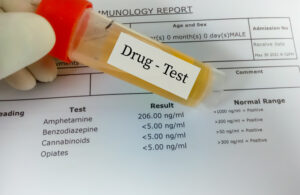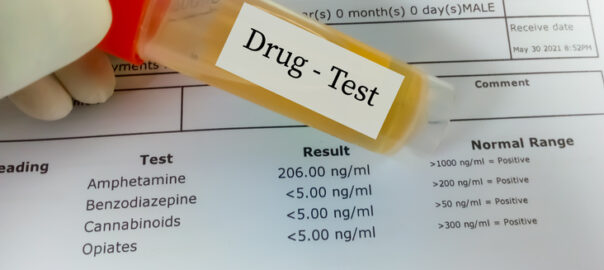The Department of Transportation (DOT) has added four new substances to its mandatory drug screening panel. Commonly abused prescription painkillers include hydrocodone, hydromorphone, oxymorphone, and oxycodone. The DOT says its new drug screening rule is designed to “enhance safety, prevent opioid substance abuse, and combat the nation’s growing opioid epidemic.” The test can detect opioid use within a 72-hour window.

Common brand names for the medications included in the drug panel include, but are not limited to:
- Dilaudid
- Exalgo
- Lortab
- Norco
- OxyContin
- Percocet
- Percodan
- Vicodin
Changes to the New Drug Testing Rule
The new drug testing rule, which took effect January 1, 2018, made two more significant changes. First, it replaced the test for methylenedioxy-N-ethylamphetamine (MDEA, also known as Ecstasy) with methylenedioxyamphetamine (MDA). Both drugs are closely related and have stimulating and hallucinogenic effects on the body. MDA stays in a person’s system longer than MDEA. MDA also causes more aggression and is a stronger hallucinogen than its counterpart.
Second, the rule also removed the requirement for blind specimen testing. Labs will still split urine samples for testing but can now identify both specimens with the donor’s name. This reduces the time required to process samples and helps defray some of the increased testing costs.
Opioid Crisis
President Trump declared a national opioid crisis in October 2017, citing the related loss of 64,000 American lives in 2017. This nearly doubles the over 33,000 fatalities from opiate overdose in 2015. Like heroin and morphine, these medications cause a euphoric state and are highly addictive.
Information from the National Institute on Drug Abuse (NIDA) indicates that 21 – 29 percent of people who take opioids for chronic pain abuse their prescription medications. The new DOT drug testing rule is part of a multifaceted effort to reduce the nation’s dependence on prescription painkillers.
Transportation Industry Workers Subject to DOT Drug Testing
The new rule impacts transportation industry workers, which includes aviation, railroad, public transit, and truck drivers. It also applies to some Coast Guard pilots, all oil pipelines, and hazardous material workers.
For drivers who are under Federal Motor Carrier Safety Administration (FMCSA) regulations, the new rule applies to drivers who
- Operate vehicles with a Gross Combination Weight Rating (GCWR) or Gross Vehicle Weight Rating (GVWR) of over 26,000 pounds.
- Transport 16 passengers or more.
- Transport hazardous materials (hazmat) loads and require placarding.
Drug Testing Process
Professional truck drivers must submit to a pre-employment drug screening. Testing is also mandatory after an accident or for random testing. Drivers must provide a urine specimen on site. The collection agent documents each sample and maintains a chain of custody to prevent tampering or contamination. The collected specimens go to a Health and Human Services (HHS) laboratory, which splits the sample and tests both to ensure consistent results.
However, drivers do not have to provide blood, saliva, or hair for drug testing. The new DOT rule also clarifies some ambiguity surrounding this issue. According to the new rule, DOT collection agents are only authorized to collect urine for drug testing. Furthermore, testing cannot take place at the collection point. Instead, the samples are sent to a laboratory for processing and official results.
Prescription Opioids
Although the public response to the expanded drug panel has been mostly positive, there are some valid concerns. Hydrocodone, hydromorphone, oxymorphone, and oxycodone are prescription medications, not street drugs. Truckers with these substances in their systems often have legitimate pain management needs. It seems unfair to punish drivers who need medication to function. Fortunately, there is some leeway in interpreting the test results.
Interpreting Positive Drug Test Results
Technically speaking, a driver who tests positive for one of the four opioids fails the drug test. However, simply failing the test is not necessarily grounds for a suspension or dismissal. Once the lab processes the sample, they forward positive and negative test results to a medical review officer (MRO). The MRO, a licensed physician, makes the final judgment call on whether the trucker can drive safely.
In most cases, when the MRO reviews a prescription-related positive result, he or she can log the result as a negative. However, after a five-day waiting period, if the medical review officer thinks it is necessary, they can issue a letter citing safety concerns preventing the driver from operating a rig until they are off the medication. The waiting period allows the MRO to consult with the driver’s prescribing physician and gather more information.
Ultimately, it is a delicate balancing act. Opioids can cause drowsiness and reduce reaction time, making it dangerous for prescribed patients to drive. On the other hand, severe pain can be a substantial distraction, too. A person with debilitating pain may be more alert while on prescription painkillers. This is one of the primary reasons MROs make each decision on a case-by-case basis.
Factors Influencing MRO Decisions
An MRO can consider several pieces of information when evaluating a driver’s ability for duty. They include whether the
- Truck driver has a prescription for that medication
- Amount of the drug in the sample
- Reason for the prescription
Some aspects of the new drug testing rule limit the scope of the medical review officer’s role. For instance, an MRO who believes a doctor is overprescribing a truck driver’s medication cannot question the doctor along that line. The MRO must also accept legally valid prescriptions, regardless of the initial prescription date.
Receiving a Positive Opioid Drug Test
If drivers know they will fail a drug test, they can refuse to provide a urine specimen. However, the DOT treats a refusal as a failure, and the driver must complete an extensive return-to-duty process before reinstatement. If you have an opioid prescription, it is in your best interest to take the test and disclose your legal use of the medication.
Providing Proof of Legal Opioid Use
Although there are no guarantees, you can reduce the chance of an MRO recommending your removal from duty. First, provide proof of your prescription, such as a bottle label or a note from your doctor. Make sure the collection agent records your pharmacy’s number and your prescription number for verification purposes. Second, provide a medical clearance statement. Having both these pieces of information shows you are legally taking the medication and that you are using it responsibly.
Receiving Medical Clearance
FMCSA rules state that opioid use constitutes a medical disqualification, even with a prescription. There is an exception to the rule if a doctor signs off on the driver’s ability to perform his or her duties. The prescribing physician making this determination must take the driver’s current medications and their “safety-sensitive duties” into consideration.
Another option for obtaining medical clearance occurs during your DOT physical. If you disclose your prescription to the doctor and they clear you to drive, this also counts as medical clearance. In either case, ask the doctor to prepare a signed statement that you can keep on file.
Considering Alternative Pain Medications
Contrary to popular opinion, it is possible to be physically dependent on medication without being addicted. Addiction is a psychological condition that drives patients to misuse their medications despite adverse effects on their health and relationships. Physical dependence means the body goes through withdrawal when it does not receive a regular dose of the substance. Over time, patients can also build up a physical tolerance to the medication, requiring a higher dose to produce the same pain-relieving effect.
Long-term opioid use for chronic pain management increases the risk of both addiction and physical dependence. It can also cause chronic constipation and other health issues. Discuss alternative pain management options with your doctor. Do not attempt to quit “cold turkey.” This is dangerous and potentially life-threatening. Instead, you and your doctor should use a slow weaning process to decrease opioid use.
Testing positive for an opioid prescription does not automatically mean you will lose your job. However, it is still a possibility. Disclosing your prescriptions, getting medical clearance, and pursuing alternative treatments for chronic pain will only help you in the long run.


